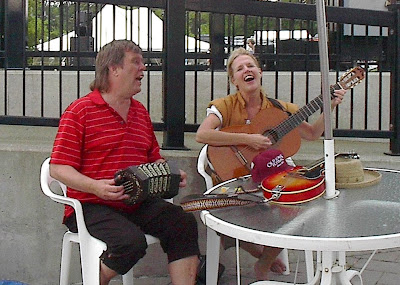
The celebration was held at the new Henry Hudson River Park, created where once six large oil tanks stood. It is a lovely little park, a good reuse of the land. From there you can see the Athens Lighthouse and the Middle Ground Flats, now an island in the river between the cities of Athens and Hudson. To the south despite a hazy sky you could see the Catskill Mountains. The Mohicans called these the Blue Mountains.

Also present for the day was the replica ship of the Halve Maen, the Dutch ship that Henry Hudson sailed to the New World for the Dutch East India Company. Captain William Reynolds said there were long lines of people waiting to go on board since 9 a.m. that day. When I left at 4 p.m., there was still a long line. While people waited, they could view a display of native artifacts and antique navigational instruments, and listen to Dutch songs performed by Nanne & Ankie.

My friend Steve Comer and I had been invited to represent the Mohican people. Steve had a display on the Mohican Nation and its history. I prepared a binder with information on my father’s paternal family descended from Mohican and Wappinger people. I also brought my finger-weaving with me, giving people a brief insight into native technology.
It was a very pleasant day. The rain stayed away for most of it. I’ve always loved being by a body of water, whether a river, lake or ocean. I enjoyed talking to the people who came by. While waiting in line to board the Halve Maen (that unfortunately I didn’t do), I had an enjoyable conversation with a very nice Naval commander from downstate and his brother, who brought his family. They surprised me greatly by asking how to get to the bank of the “lake” in Philmont. They definitely asked the right person since I lived for 19 years in a house on the bank of the Philmont reservoir. I think it was the best view in town

